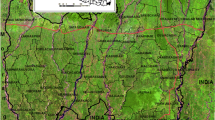Abstract
Vector borne diseases are a threat to human health. Little attention has been paid to the prevention of these diseases. We attempted to identify the significant wetland characteristics associated with the spread of chikungunya, dengue fever and malaria in Kerala, a tropical region of South West India using multivariate analyses (hierarchical cluster analysis, factor analysis and multiple regression). High/medium turbid coastal lagoons and inland water-logged wetlands with aquatic vegetation have significant effect on the incidence of chikungunya while dengue influenced by high turbid coastal beaches and malaria by medium turbid coastal beaches. The high turbidity in water is due to the urban waste discharge namely sewage, sullage and garbage from the densely populated cities and towns. The large extent of wetland is low land area favours the occurrence of vector borne diseases. Hence the provision of pollution control measures at source including soil erosion control measures is vital. The identification of vulnerable zones favouring the vector borne diseases will help the authorities to control pollution especially from urban areas and prevent these vector borne diseases. Future research should cover land use cover changes, climatic factors, seasonal variations in weather and pollution factors favouring the occurrence of vector borne diseases.














Similar content being viewed by others
References
Anurag, B., & Biswaroop, C. (2007). Chikungunya fever, falciparum malaria, dengue fever, Japanese encephalitis… are we listening to the warning signs for public health in India? Indian Journal of Medical Ethics, IV(1). http://www.issuesinmedicalethics.org/pdfs/151sa18.pdf
Coughanowr, C. (1998). Wetlands of the humid tropics. IHP Humid tropics programme. Series no. 12. http://unesdoc.unesco.org/images/0011/001160/116084eo.pdf
Coughanowr, C. (2010a). State bulletin-2010. Integrated disease surveillance project. Thiruvananthapuram: Directorate of Health Services, Government of Kerala.
Coughanowr, C. (2010b). National wetland atlas: Kerala. Ahmedabad: Space Applications Centre, Indian Space Research Organisation. http://moef.nic.in/sites/default/files/NWIA_Kerala_Atlas.pdf
Coughanowr, C. (2010c). Water and Air quality directory 2009. Thiruvananthapuram: Kerala State Pollution Control Board.
Irvine, E., Somogye, E. L., Pettibone, G. W., et al. (2002). Turbidity, suspended solids and bacteria relationships in the Buffalo river watershed. Middile State Geographer, 35, 42–51. http://geographyplanning.buffalostate.edu/MSG%202002/5_Irvine_et_al.pdf
Karthikeyan, M., Meenakshi, K. D. A., et al. (2011). Study on chikungunya outbreak of 2009 in Balussery, Kozhikode, India. Journal of Experimental and Integrated Medicine. 1(1), 59–62. http://www.jeim.org/?mno=2037
Kenea, O., Balkew, M., & Gebre-Michael, T. (2011). Environmental factors associated with larval habitats of anopheline mosquitoes in irrigation and major drainage areas in the middle course of the rift valley, Central Ethiopia. Journal of Vector Borne Diseases, 48, 85–92.
Liu, Y., Islam, M. A., Gao, J., et al. (2003). Quantification of shallow water quality parameters by means of remote sensing. Progress in Physical Geography, 27, 24–43.
Mereta, S. T., Yewhalaw, D., Boets, P., Ahmed, A., Duchateau, L., Speybroeck, N., et al. (2013). Physico-chemical and biological characterization of anopheline mosquito larval habitats (Diptera: Culicidae): Implications for malaria control. Parasites and Vectors, 6, 320.
Muture, E. J., Mwangangi, J., Shililu, J., Jacob, B. G., Mbogo, C., Githure, J., et al. (2008). Environmental factors associated with the distribution of Anopheles arabiensis and Culex quinquefasciatus in a rice agro-ecosystem in Mwea, Kenya. Journal of Vector Ecology, 33(1), 56–63.
Nabar, B. M., Shepal, K. B., Leleand, H. M., & Lokegaonkar, S. P. (2011). Statistical survey of mosquito vectors in the vicinity of Waldhuni water body, district Thane-India. West African Journal of Applied Ecology, 19, 2011.
Rao, N. B. (2000). Larval habitats of Aedes albopictus (skuse) in rural areas of Kozhikode, Kerala, India. Journal of Vector Borne Diseases, 1-9-2000. http://www.mrcindia.org/journal/issues/473175.pdf
Richarme, M. (2002). Eleven multivariate analysis techniques key tools in your marketing research survival kit. Decision Analyst. http://www.decisionanalyst.com/publ_art/multivariate.dai
Sarneckis, K. (2002). Mosquitoes in constructed wetlands. Environmental Protection Agency. Government of South Australia, 20. www.epa.sa.gov.au/xstd_files/Air/Report/mosquitoes.pdf
Sheela, A. M., Letha, J., & Joseph, S. (2010). Environmental status of a tropical lake system. Environmental Monitoring and Assessment, 180(1–4), 427–449. doi:10.1007/s10661-010-1707-5
Sheela, A. M., Letha, J., Joseph, S., et al. (2011). Need for sustainable planning with respect to water quality and land use change. NATCON 2011 organized by the College of Engineering, Thiruvananthapuram from January 28–29, 2011. http://academia.edu/1224585/Need_for_Sustainable_Planning_with_reference_to_Land_Use_and_Water_Quality
Sheela, A. M., Letha, J., Joseph, S., Ramachandran, K. K., & Justus, J. (2013). Assessment of pollution status of a coastal lake system using satellite imagery. Geophysics and Remote Sensing, 2, 1. doi:10.4172/2169-0049.1000110
Shililu, J., Ghebremeskel, T., Mengistu, S., Fekadu, H., Zerom, M., Mbogo, C., et al. (2003). Distribution of anopheline mosquitoes in Eritrea. American Journal of Tropical Medicine and Hygiene, 69(3), 295–302.
Tennessen, K. (1993). Production and suppression of mosquitoes in constructed wetlands. In G. Moshiri (Ed.), Constructed wetlands for water quality improvement. London: Lewis Publishers.
Vinod, S. (2011). Deforestation and water pollution impact on mosquitoe related epidemic diseases in Nanded region. Bioscience Discovery, 2(3), 309–316.
Yadav, P. (2009). Factors affecting mosquito populations in created wetlands. Environmental Science Graduate Program of the Ohio State University, 1(1), 43.
Acknowledgments
We are grateful to Directorate of Health Sciences, Thiruvananthapuram, Kerala State Remote Sensing Agency, Thiruvananthapuram, and Centre for Geoinformatics, Science and Technology, University of Kerala, Thiruvananthapuram for their support in the study.
Author information
Authors and Affiliations
Corresponding author
Rights and permissions
About this article
Cite this article
Sheela, A.M., Sarun, S., Justus, J. et al. Assessment of changes of vector borne diseases with wetland characteristics using multivariate analysis. Environ Geochem Health 37, 391–410 (2015). https://doi.org/10.1007/s10653-014-9655-y
Received:
Accepted:
Published:
Issue Date:
DOI: https://doi.org/10.1007/s10653-014-9655-y




